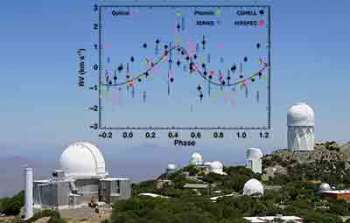sci16008 — Announcement
NOAO in the News:
May 31, 2016
Young Mammoth Cluster of Galaxies Sighted in the Early Universe
Astronomers have uncovered evidence for a vast collection of young galaxies 12 billion light years away. The newly discovered “proto-cluster” of galaxies, observed when the universe was only 1.7 billion years old (12% of its present age), is one of the most massive structures known at that distance. The discovery was made using telescopes at KPNO and Keck Observatory. NOAO Astronomer Arjun Dey is the lead author of the study. Read more in NOAO Press Release 16-01.
Small blue galaxy could shed new light on Big Bang
Located 30 million light-years away, the dwarf galaxy AGC198691 contains the lowest level of heavy elements ever observed in a galaxy. The low abundance indicates a near-pristine chemical composition, very close to that of the early universe, that has been little “polluted” by earlier generations of stars. Spectra obtained with the KPNO 4-m Mayall telescope led to the discovery. Read more in the Indiana University Press Release.
Giant Planet Discovered Around a Very Young Star:
In a rare find, astronomers have detected a young giant planet still embedded in its natal disk of gas and dust. The planet was detected by the wobble it induces in the star that it orbits. The discovery may lend new insights into how planets form. Spectra from the KPNO 2.1m and Mayall telescopes were used in the discovery. Read more in the Rice University press release.
Puffy Giant Planet Discovered by KELT-S Transit Survey
Transiting planets orbiting bright stars provide a golden opportunity to learn about the nature of exoplanets, their composition and origin. KELT-S, a robotic survey of the southern sky that is designed to detect transiting planets orbiting bright stars, reports its first discovery: a highly inflated giant planet. The planet, KELT-10b, is an attractive target for future studies aimed at characterizing planetary atmospheres. NOAO astronomer David James is a founding member of the survey. Read more…
About the Announcement
| Id: |
ID
sci16008
|

